Cải cách thuế ở Việt Nam: Hướng tới một hệ thống hiệu quả và công bằng hơn
Năm 2010, sau hai thập kỷ cải cách, Việt Nam đã vượt ngưỡng thu nhập thấp và tham gia
vào nhóm các nước có thu nhập trung bình. Cải cách theo hướng kinh tế thị trường và hội
nhập với nền kinh tế thế giới là những động lực chủ yếu mang lại kết quả này. Cải cách
chính sách và quản lý thuế là một bộ phận quan trọng trong quá trình chuyển đổi sang nền
kinh tế thị trường. Quá trình chuyển đổi này đã dẫn đến những thay đổi cơ bản trong cơ
cấu đối tượng nộp thuế, vốn chủ yếu là các doanh nghiệp nhà nước và doanh nghiệp có
vốn đầu tư nước ngoài lớn nay chuyển dần sang hàng triệu doanh nghiệp tư nhân vừa và
nhỏ. Quá trình chuyển đổi kinh tế cũng dẫn đến một thay đổi không kém quan trọng về
nguồn thu ngân sách nhà nước, từ thuế đánh vào giao dịch ngoại thương và nguồn thu từ
khai thác dầu thô sang nguồn thuế nội địa, cụ thể là thuế thu nhập doanh nghiệp, thuế thu
nhập cá nhân và thuế liên quan đến đất đai. Tuy nhiên hoàn thiện quá độ sang nền kinh
tế thị trường sẽ đòi hỏi không chỉ các thay đổi thủ tục về thu thuế và quản lý thuế mà còn
liên quan đến những thay đổi tự thân các công cụ thuế nữa. Khi quá trình chuyển đổi hoàn
thành, Việt Nam cần phải có một hệ thống các sắc thuế đơn giản và minh bạch, đảm bảo
nguồn thu ổn định cho nhà nước, khuyến khích phân bổ nguồn lực hiệu quả và không tạo
ra sự mất công bằng.
Kế hoạch Phát triển Kinh tế - Xã hội 2011-2015 đã đặt ra một mục tiêu đầy tham vọng. Trong
giai đoạn 5 năm tới, thu ngân sách nhà nước phải đảm bảo ổn định kinh tế vĩ mô và đầu tư vào
các hạng mục cơ sở hạ tầng cơ bản. Tổng mức thu ngân sách trung bình phải đạt từ 25,1 đến
25,4% GDP, trong đó nguồn thu từ thuế và lệ phí đạt 23.0 đến 24.0% GDP. Tổng thu dự tính
đạt khoảng 3.880 nghìn tỉ Đồng, tức là gấp 1,5 lần so với thời kỳ 2006-2010. Như vậy mức
tăng thu ngân sách nhà nước bình quân hàng năm sẽ vào khoảng 15,6%.
Mục đích của loạt bài nghiên cứu trong tập sách này là làm rõ các vấn đề mà Việt Nam sẽ
phải đối mặt trong quá trình cải cách chính sách và công tác quản lý thuế của mình. Các
bài nghiên cứu cũng sẽ đề xuất các khuyến nghị chính sách cụ thể đóng góp vào công tác
chuẩn bị các chính sách và văn bản pháp qui quan trọng nhằm đảm bảo thực hiện được mục
tiêu về thu ngân sách nhà nước và các mục tiêu cải cách ngành quản lý thuế khác trong Kế
hoạch Phát triển Kinh tế - Xã hội 2011-2015. Hy vọng các bài nghiên cứu riêng rẽ trong
loạt bài này cũng sẽ được sử dụng làm tài liệu đầu vào cho các cuộc tranh luận xung quanh
việc ban hành các luật và qui định mới. Hy vọng ấn phẩm này sẽ hỗ trợ đà cải cách trong
lĩnh vực chính sách thuế, góp phần tăng tính hiệu quả, tính minh bạch và tính công bằng
của hệ thống thuế.
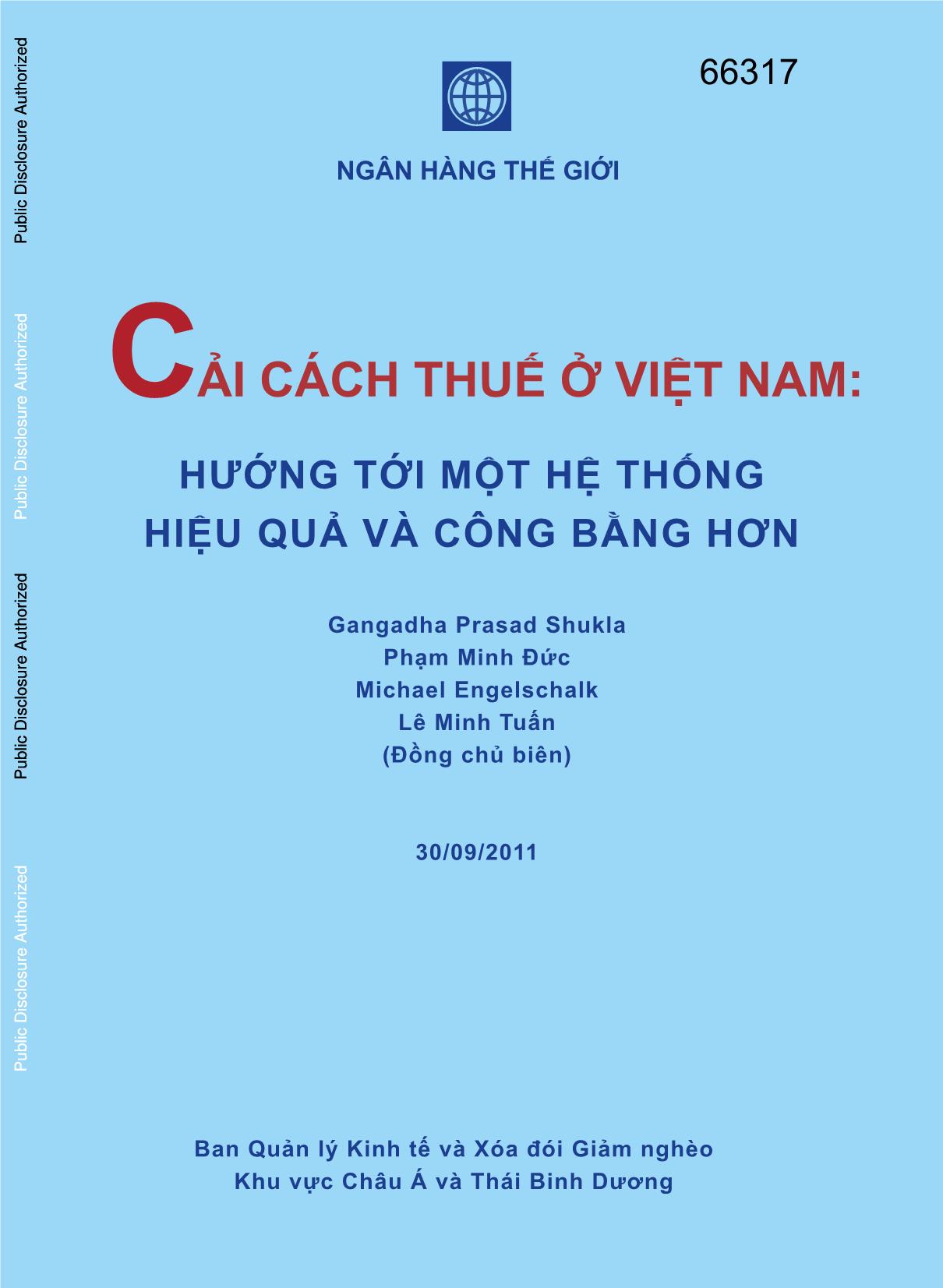
Trang 1

Trang 2
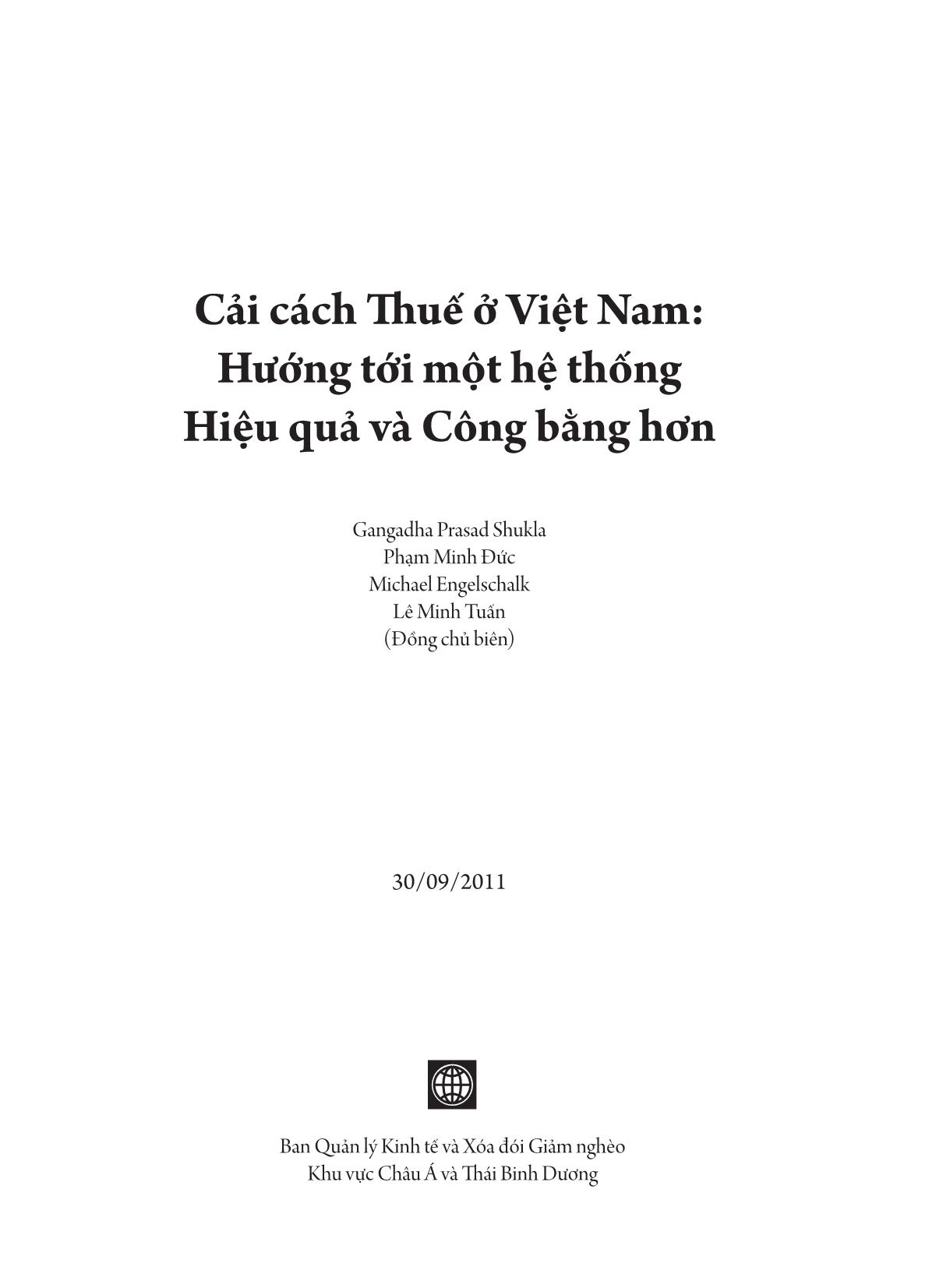
Trang 3

Trang 4
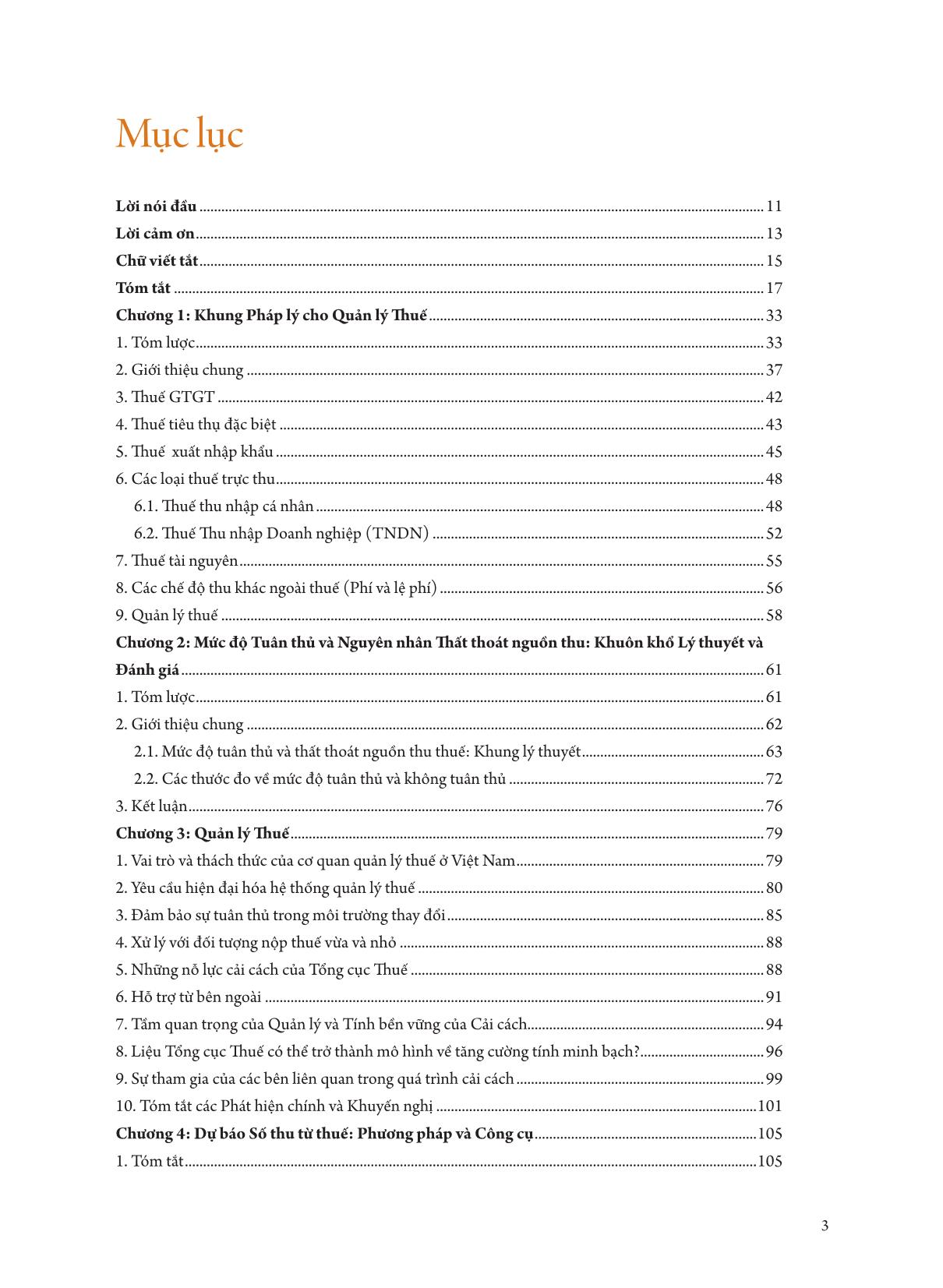
Trang 5
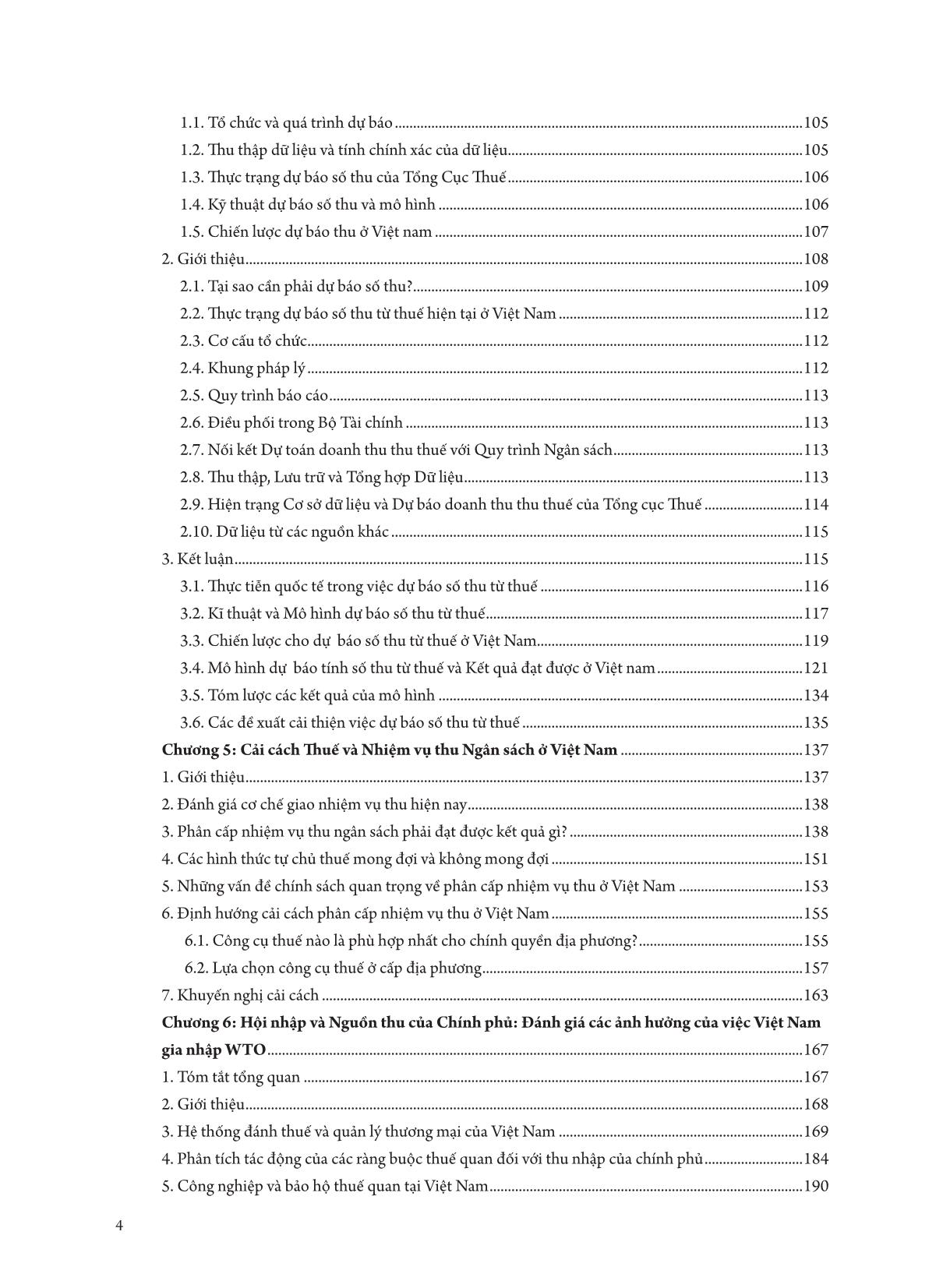
Trang 6
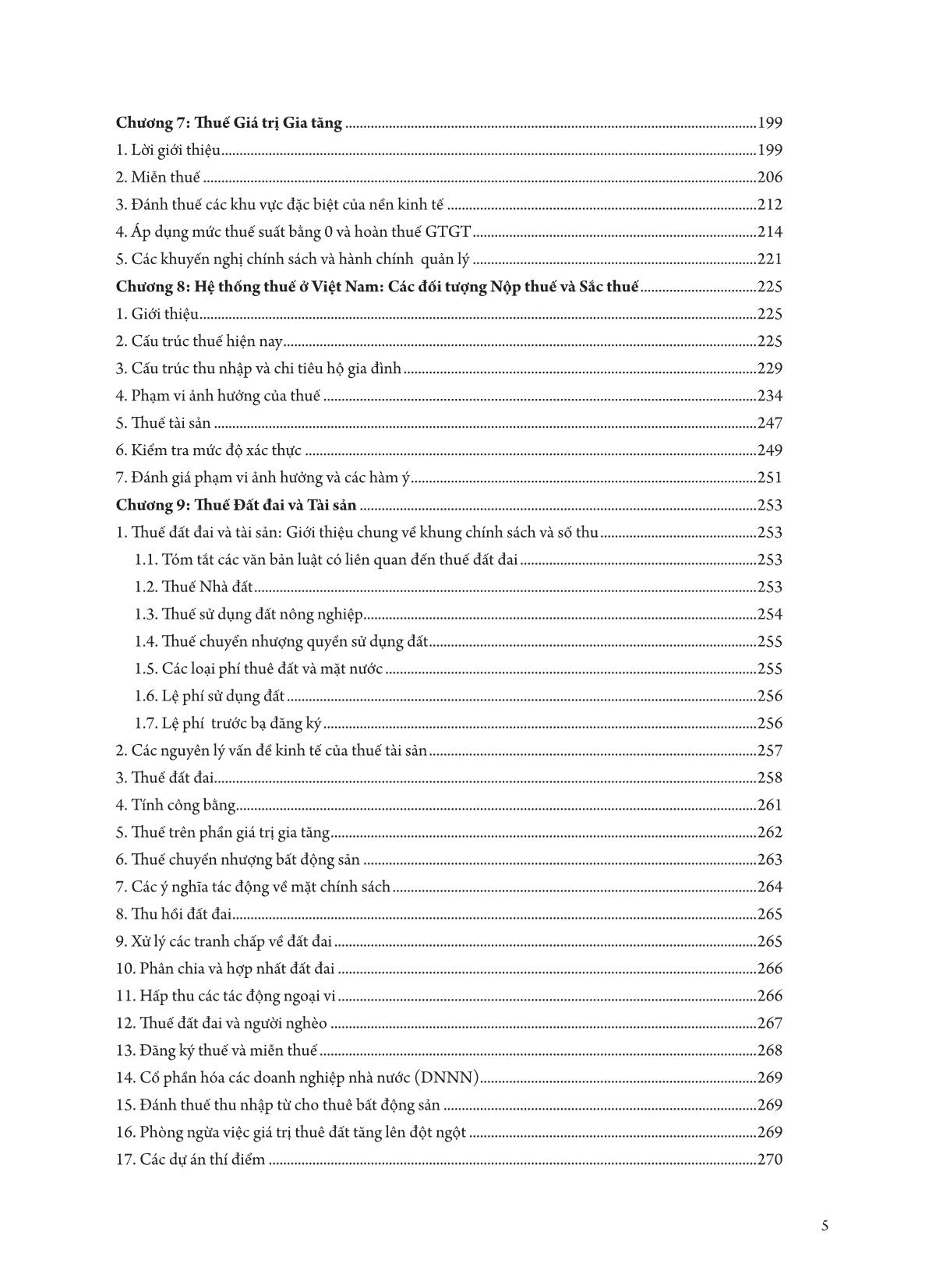
Trang 7
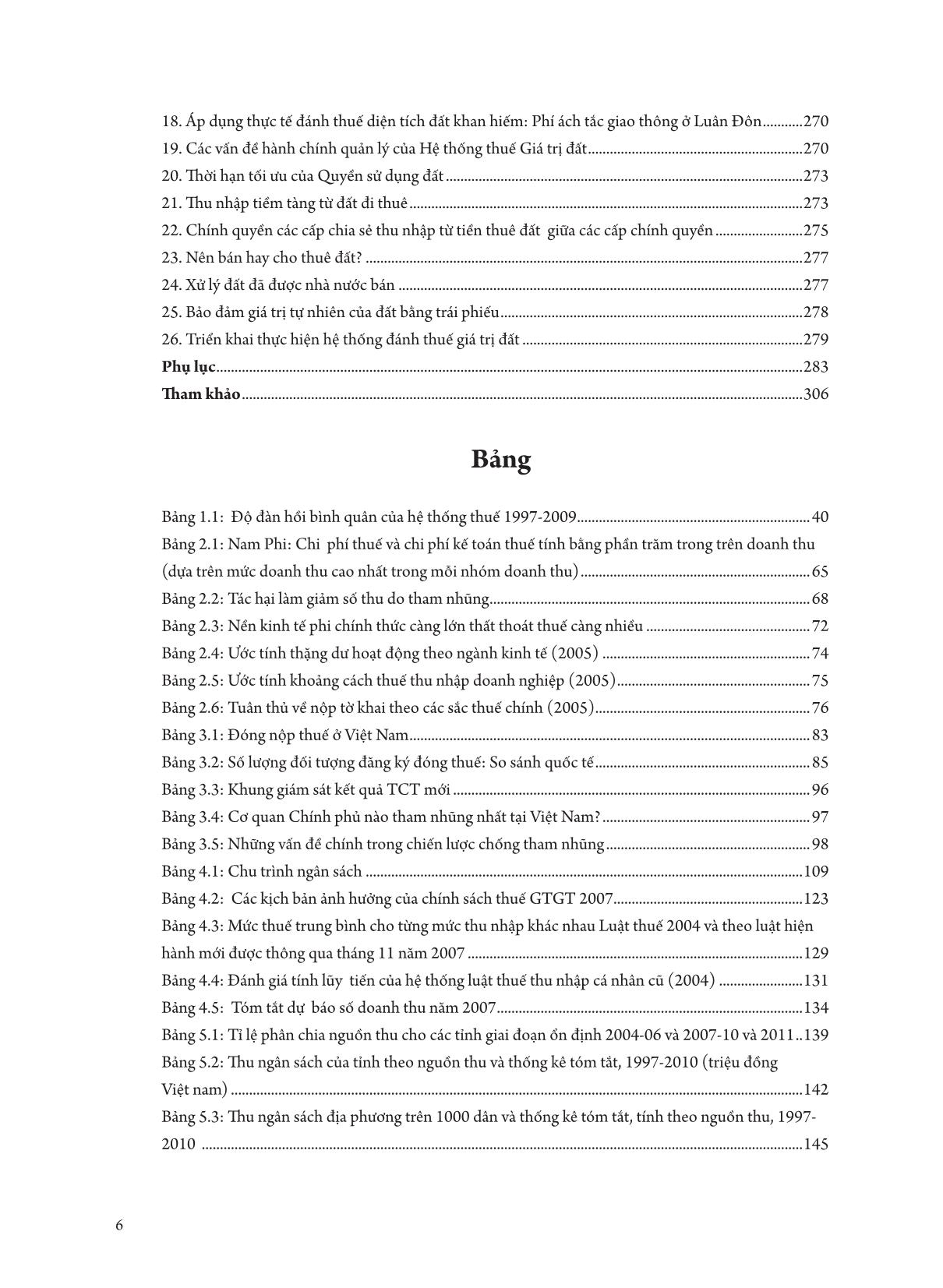
Trang 8

Trang 9
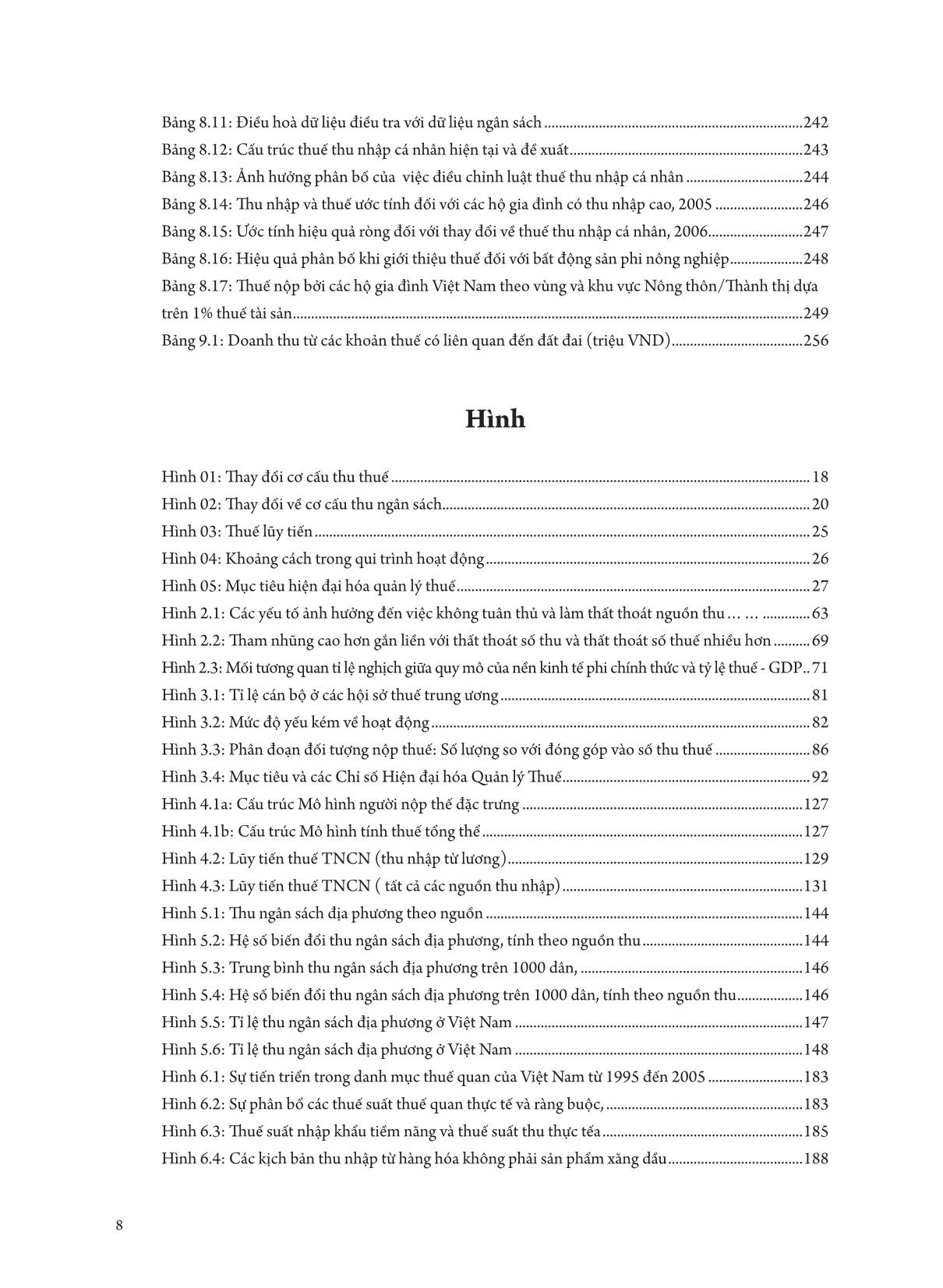
Trang 10
Tải về để xem bản đầy đủ
Tóm tắt nội dung tài liệu: Cải cách thuế ở Việt Nam: Hướng tới một hệ thống hiệu quả và công bằng hơn

Ban Quản lý Kinh tế và Xóa đói Giảm nghèo Khu vực Châu Á và Thái Binh Dương NGÂN HÀNG THẾ GIỚI Gangadha Prasad Shukla Phạm Minh Đức Michael Engelschalk Lê Minh Tuấn (Đồng chủ biên) 30/09/2011 HƯỚNG TỚI MỘT HỆ THỐNG HIỆU QUẢ VÀ CÔNG BẰNG HƠN ẢI CÁCH THUẾ Ở VIỆT NAM: C Pu bl ic Di sc lo su re A ut ho riz ed Pu bl ic Di sc lo su re A ut ho riz ed Pu bl ic Di sc lo su re A ut ho riz ed Pu bl ic Di sc lo su re A ut ho riz ed Pu bl ic Di sc lo su re A ut ho riz ed Pu bl ic Di sc lo su re A ut ho riz ed Pu bl ic Di sc lo su re A ut ho riz ed Pu bl ic Di sc lo su re A ut ho riz ed Cải cách Thuế ở Việt Nam: Hướng tới một hệ thống Hiệu quả và Công bằng hơn Gangadha Prasad Shukla Phạm Minh Đức Michael Engelschalk Lê Minh Tuấn (Đồng chủ biên) 30/09/2011 Ban Quản lý Kinh tế và Xóa đói Giảm nghèo Khu vực Châu Á và Thái Binh Dương 3Mục lục Lời nói đầu ........................................................................................................................................................... 11 Lời cảm ơn ............................................................................................................................................................ 13 Chữ viết tắt ........................................................................................................................................................... 15 Tóm tắt .................................................................................................................................................................. 17 Chương 1: Khung Pháp lý cho Quản lý Thuế ............................................................................................ 33 1. Tóm lược ............................................................................................................................................................ 33 2. Giới thiệu chung .............................................................................................................................................. 37 3. Thuế GTGT ...................................................................................................................................................... 42 4. Thuế tiêu thụ đặc biệt ..................................................................................................................................... 43 5. Thuế xuất nhập khẩu ...................................................................................................................................... 45 6. Các loại thuế trực thu ...................................................................................................................................... 48 6.1. Thuế thu nhập cá nhân ........................................................................................................................... 48 6.2. Thuế Thu nhập Doanh nghiệp (TNDN) ........................................................................................... 52 7. Thuế tài nguyên ................................................................................................................................................ 55 8. Các chế độ thu khác ngoài thuế (Phí và lệ phí) ......................................................................................... 56 9. Quản lý thuế ..................................................................................................................................................... 58 Chương 2: Mức độ Tuân thủ và Nguyên nhân Thất thoát nguồn thu: Khuôn khổ Lý thuyết và Đánh giá ................................................................................................................................................................ 61 1. Tóm lược ............................................................................................................................................................ 61 2. Giới thiệu chung .............................................................................................................................................. 62 2.1. Mức độ tuân thủ và thất thoát nguồn thu thuế: Khung lý thuyết .................................................. 63 2.2. Các thước đo về mức độ tuân thủ và không tuân thủ ...................................................................... 72 3. Kết luận .............................................................................................................................................................. 76 Chương 3: Quản lý Thuế .................................................................................................................................. 79 1. Vai trò và thách thức của cơ quan quản lý thuế ở Việt Nam .................................................................... 79 2. Yêu cầu hiện đại hóa hệ thống quản lý thuế ................................................ ... ford University Press. Washington DC. Bird, Richard M. 2000. “Rethinking Subnational Taxes: A New look at Tax Assignment.” Tax Notes International 8: 2069–96. Bird, Richard M. 2003. “A New Look At Local Business Taxes.” Tax Notes International 30: 695. Bird, Richard M., and Enid Slack. 2004. International Handbook of Land and Property Taxation. London: Edward Elgar Publishing. Bird, Richard M., and Milka Casanegra de Jantscher, eds. 1992. Improving Tax Administration in Developing Countries. Washington, DC: International Monetary Fund. Bird, Richard M., Jorge Martinez-Vazquez, and Benno Torgler. 2004. Societal Institutions and Tax Efforts in Developing Countries. Working Paper 04-06. Andrew Young School of Policy Studies, Georgia State University, Atlanta. Boadway, Robin. 1997. Tax Assignment in the Canadian Federal System. Reshaping Fiscal Federalism in Australia, ed. Neil A. Warren. Sidney: Australian Tax Foundation, pp. 61–90. T H A M K H Ả O 307 Boadway, Robin, Maurice Marchand, and Marianne Vigneault. 1998. The Consequences of Overlapping Tax Bases for Redistribution and Public Spending in a Federation. Journal of Public Economics 68 ( June): 453–78. Bourguignon, Francois, and Luiz Pereira da Silva, eds. 2003. The Impact of Economic Policies on Poverty and Income Distribution. Washington DC: World Bank and Oxford University Press. Booz Allen Hamilton. 2007. Business Process Re-engineering Baseline Findings. Internal Document. Centre for International Economics (CIE). 2004a. Revenue impacts of WTO accession: Vietnam’s customs modernisation. Canberra: Centre for International Economics. ——. 2004b. “WTO Accession and Industry: Assessing the Implications of Tariff Commitments. Canberra: Centre for International Economics. ——. 2007. “Vietnam’s WTO Accession: Assessing the Implications of Tariff Binding Commitments.” Report prepared for the Asian Development Bank, Centre for International Economics, Canberra. Casanegra de Jantscher, Milka, and Richard Bird. 1992. Improving Tax Administration in Developing Countries. Washington DC: International Monetary Fund. Choi, Jay Pil, and Marcel Thum. 2005. Corruption and the Shadow Economy. International Economic Review 46 (3) (August). Citro, C. F., and E. A. Hanushek, eds. 1991. The Uses of Microsimulation Modeling. Vol. 1, Review and Recommendations. Washington, DC: National Academy Press. Das-Gupta, Arindam, Engelschalk, Michael, Mayville, William. 1999. An Anti-Corruption Strategy for Revenue Administration. World Bank PREM Note 33, World Bank, Washington, DC. De Jantscher, M. Casanegra. 1990. Administering a VAT. In Value Added Taxation in Developing Countries, M. Gillis, C. S. Shoup, and G. P. Sicat, eds. World Bank: Washington, DC. Deaton, Angus, and Salman Zaidi. 2002. Guidelines for Constructing Consumption Aggregates for Welfare Analysis. Living Standards Measurement Surveys Working Paper 135, World Bank, Washington DC. Demery, Lionel. 2000. Benefit Incidence: A Practitioner’s Guide. Washington, DC: World Bank. Ebel, Robert D., and Serdar Yilmaz. 2002. On the Measurement and Impact of Fiscal Decentralization. World Bank Policy Research Working Paper No. 2809, World Bank, Washington, DC, March. Ebrill, Liam, Michael Keen, Jean-Paul Bodin, and Victoria Summers. 2001. The Modern VAT. International Monetary Fund, Washington, DC. EIU (Economist Intelligence Unit). 2008. Vietnam: Country Report – April 2008. London. 308 C Ả I C Á C H T H U ế ở V I ệ T N A M Engelschalk, Michael, Dana Weist, and Samia Melhem. 2000. Computerizing Tax and Customs Administrations. World Bank PREM Note 44, World Bank, Washington, DC. General Statistics Office. 2008. ID=6540. Gordon, Richard K. 1996. Law of Administration and Procedure. In Tax Law Design and Drafting, Vol. 1, ed. V. Thuronyi. International Monetary Fund, Washington, DC. GSO (General Statistical Office of Vietnam). 2001. Some Issues in Compliance of Main Accounts by International Sectors in Vietnam. Country Report for Interregional Workshop on the 1993 System of National Accounts, May 7–11, Manila, the Philippines. Gupta A., and A. Harding, eds. 2007. Modeling our Future, Population Ageing, Social Security and Taxation. International Symposia in Economic Theory and Econometrics. Amsterdam: Elsevier. Gupta, A., and K. Vishnu. 2000. Micro-simulation in Government Policy and Forecasting. Amsterdam: North-Holland: Elsevier Science Ltd. Harrison, Graham, and Russel Krelove. 2005. VAT Refund: A Review of Country Experience. IMF Working Paper, International Monetary Fund, Washington, DC, November. Haughton, Jonathan. 2004. An Assessment of the Tax System of Lebanon. For office of Prime Minister, Beirut. ——. 2005. An Assessment of Tax and Expenditure Incidence in Peru. For the Inter-American Development Bank. Haughton, Jonathan, Nguyen The Quan, and Nguyen Hoang Bao. 2006. Tax Incidence in Vietnam. Asian Economic Journal 20 (2): 217–39. IFC (International Finance Corporation). 2007. Tax Compliance Cost Survey. Washington, DC. IMF (International Monetary Fund). 2006. Vietnam: Statistical Appendix, IMF Country Report No. 06/423. International Monetary Fund, Washington, DC. ——. 2007. Vietnam: Statistical Appendix, IMF Country Report No. 07/386. International Monetary Fund, Washington, DC. Investment and Trade Promotion Centre (ITPC). 2007. Vietnam’s Custom Tariff Schedule 2006. schedule_2006 ITD. 2007. Taxation of Small and Medium Enterprises. Background paper prepared for ITD Global Conference, Buenos Aires, Argentina, October. background%20paper.pdf>. Jenkins, Glenn P., Chun-Yan Kuo, and G. P. Shukla. 2000. Tax Analysis and Revenue Forecasting – Issues and Techniques. Cambridge, Massachusetts: Harvard Institute for International Development, Harvard University. T H A M K H Ả O 309 Johnson, S., D. Kaufmann, and A. Shleifer. 1997. The Unofficial Economy in Transition. Brookings Papers on Economic Activity, Brookings Institution, Washington, DC. Johnson, Simon, Daniel Kaufmann, and Pablo Zoido-Lobaton. 1998. Regulatory Discretion and the Unofficial Economy. American Economic Review 88 (2). Keen, Michael. 2003. Tax Reform in Italy. Tax Notes International 17 (February): 665–82. Kiefer, Donald W. 2001. Distributional Tax Progressivity Indexes. National Tax Journal 37: 497–513. King, John. 1995. Alternative Methods of Revenue Forecasting and Estimating. In Tax Policy Handbook, ed. P. Shome. Washington, DC: International Monetary Fund. Kyobe, A., and S. Danninger. 2005. Revenue Forecasting – How is it Done? Results from a Survey of Low-Income Countries. International Monetary Fund Working Paper, International Monetary Fund, Washington, DC. Le, Minh Tuan. 2007. Estimating the VAT Base: Methodology and Application. Tax Notes International 46 (2) (April). Le, Minh Tuan Le et al. 2008. Expanding Taxable Capacity and Reaching Revenue Potential: Cross-Country Analysis. World Bank Working Paper No. 4559, World Bank, Washington, DC, March. Linn, Johannes F. 1983. Cities in the Developing World: Policies for Their Equitable and Efficient Growth. Oxford: Oxford University Press. Lopez Laborda, J., Jorge Martinez-Vazquez, and C. Monasterio. Forthcoming. The Practice of Fiscal Federalism in Spain. In The Practice of Fiscal Federalism: Comparative Perspectives, ed. A. Shah. The Forum of Federations. Atlanta, USA. Martinez-Vazquez, Jorge. Forthcoming. Revenue Assignments in the Practice of Fiscal Decentralization. In Fiscal Federalism and Political Decentralization, ed. Nuria Bosch and Jose Maria Duran. Atlanta: Edward Elgar, U.K. Martinez-Vazquez, Jorge, and Jameson Boex. 2001. Russia’s Transition to a New Federalism, with, World Bank Institute Learning Resources Series. Washington, DC: World Bank. Martinez-Vazquez, Jorge, and Robert McNab. 2006. Fiscal Decentralization, Macroeconomic Stability, and Economic Growth. Hacienda Pública Española-Revista de Economía Pública, no. 179. Martinez-Vazquez, Jorge, Andrey Timofeev, and Jameson Boex. 2006. Reforming Regional- Local Finance in Russia. World Bank Institute Learning Resources Series. Washington, DC: World Bank. Martinez-Vazquez, Jorge, Charles E. McLure, Jr., and Francois Vaillancourt. 2006. Revenues and Expenditures in an Intergovernmental Framework. In Perspectives on Fiscal Federalism, ed. R. Bird and F. Vaillancourt. Washington, DC: World Bank. 310 C Ả I C Á C H T H U ế ở V I ệ T N A M McLure, Charles E., Jr. 1996. The Sharing of Taxes on Natural Resources and the Future of the Russian Federation. In Russia and the Challenge of Fiscal Federalism, ed. Christine I. Wallich. Washington, DC: World Bank. ——. 1998. The Tax Assignment Problem: Ends, Means, and Constraints. Public Budgeting and Financial Management 9 (4): 652–83. ——. 2000. Tax Assignment and Subnational Fiscal Autonomy. Bulletin for International Fiscal Documentation (December): 626–35. Musgrave, Richard A. 1959. The Theory of Public Finance. New York: McGraw-Hill. ——. 1983. Who Should Tax, Where, and What? In Tax Assignment in Federal Countries, ed. Charles E. McLure, Jr. Canberra: Center for Research on Federal Financial Relations, pp. 2–19. Nellor, David. 1987. The Effect of Value Added Tax on the Tax Ratio. IMF Working Paper 87/47. International Monetary Fund, Washington, DC. Norregard, John. 1997. Tax Assignment. In Fiscal Federalism in Thoery and Practice, ed. Teresa Ter-Minassian. Washington, DC : International Monetary Fund, pp. 49–72. OECD (Organisation for Economic Co-operation and Development). 2001. Compliance Measurement – Practice Note. Prepared by the OECD Committee of Fiscal Affairs Forum on Strategic Management. OECD, Paris. ——. 2001. Principles of Good Tax Administration. OECD, Paris. ——. 2004. Compliance Risk Management: Managing and Improving Tax Compliance. OECD, Paris. ——. 2007. Taxation and Governance. Policy Paper (draft of October 31). OECD, Paris. ——. 2010. Tax Administration in OECD and Selected Non-OECD Countries: Comparative Information Series. OECD, Paris. ——. 2011. Cutting Red Tape – Administrative Simplification in Viet Nam, 2011. OECD, Paris. Plassmann, Florenz, and T. Nicolaus Tideman. Forthcoming. Accurate Valuation in the Absence of Markets. Public Finance Review. Available as a working paper at: edu/wp01/WP0101.pdf. Sah, Raaj K. 1983. How much Redistribution is Possible through Commodity Taxes? Journal of Public Economics 20 (1): 89–101. Sanford, C. T. 1995. Tax Compliance Costs: Measurement and Policy. Bath: Fiscal Publications. Schneider, Friedrich, and Dominik Enste. 2000. Shadow Economies: Size, Causes, and Consequences. Journal of Economic Literature 38 (March): 77–114. Schneider, Friedrich, and Robert Klinglmair. 2004. Shadow Economies around the World: What Do We Know? IZA, Bonn. T H A M K H Ả O 311 Schneider, Friedrich, Andreas Buehn, and Claudio E. Montenegro. 2010. New Estimates for the Shadow Economy all over the World. International Economic Journal 24 (4): 443–61. Sennoga, Edward, David Sjoquist, and Wallace. 2007. Incidence and Economic Impacts of Property Taxes in Developing and Transitional Countries. In Making the Property Tax Work in the Developing World, ed. Roy Bahl, Jorge Martinez-Vazquez, and Joan Youngman. Georgia State University, Atlanta, Georgia. Shome, P. 1988. On the Elasticity of Developing Country Tax Systems. Economic and Political Weekly XXIII (34) (August 20). Shome, Parthasarathi, ed. 1995. Tax Policy Handbook. Washington, DC: Fiscal Affairs Department, International Monetary Fund. Shoven J. B., and J. Whalley. 1984. Applied General Equilibrium Models of Taxation and International Trade: An Introduction and Survey. Journal of Economic Literature 22: 1007–51. Shukla, G. P. 2006. Tax Policy Analysis and Legal Framework: Taxation Reform and Modernization Program, Vietnam. Duke Center for International Development, Duke University, Durham, North Carolina. ——. 2007. Tax Policy Analysis and Legal Framework: Taxation Reform and Modernization Program, Vietnam. Duke Center for International Development, Duke University, Durham, North Carolina. Tait, Alan A. 1988. Value Added Tax: International Practice and Problems. International Monetary Fund, Washington, DC. ——. 1991. “Value Added Tax: Administrative and Policy Issues.” International Monetary Fund, Washington, DC. Tanzi, Vito, and Hamid Davoodi. 1997. Corruption, Public Investment, and Growth. Working Paper/97/139, International Monetary Fund, Washington, DC. Tanzi, Vito, and Hamid Davoodi. 2000. Corruption, Growth & Public Finances. Working Paper/00/182, International Monetary Fund, Washington, DC. Tenev, Stoyan, Amanda Carlier, Omar Chaundry, and Quynh-Trang Nguyen. 2003. Informality and the Playing Field in Vietnam’s Business Sector. International Finance Corporation, World Bank and Mekong Private Sector Development Facility. Ter-Minassian, Teresa. 1997. Fiscal Federalism in Theory and Practice. Washington, DC: International Monetary Fund. Tuerck, David, Jonathan Haughton, Keshab Bhattarai, Phuong Viet Ngo, and Alfonso Sanchez- Penalver. 2006. The Economic Effects of the FairTax: Results from the Beacon Hill Institute CGE Model. Boston MA: Beacon Hill Institute, Suffolk University. United Nations. 1999. Handbook of Input-Output Table Compilation and Analysis. New York: United Nations. 312 C Ả I C Á C H T H U ế ở V I ệ T N A M Vickrey, W. 1961. Counterspeculation, Auctions and Competitive Sealed Tenders. Journal of Finance 16 (May): 837. Vietnam Law Data. 2004. Vietnam’s Import-Export Tariff, September 2003. Hanoi. Watanabe, Satoshi, and Duong Thi Ninh. 2006. Indirect Tax Reform. In The Final Report of the Joint Research Program in the Vietnamese Tax System. Tax Policy Department, Ministry of Finance, Government of Vietnam. Wilson, John Douglas. 1999. Theories of Tax Competition. National Tax Journal 52 (2): 269– 304. World Bank. 2004. Public Expenditure Review and Integrated Fiduciary Assessment. World Bank, Vietnam. ——. 2006. Vietnam Development Report: Business. World Bank, Washington, DC. ——. 2007. Project Appraisal Document, Tax Administration Modernization Project. World Bank, Washington, DC. ——. 2008. Vietnam Development Report: Social Protection. World Bank, Washington, DC. ——. 2010. Doing Business 2011 – Making a Difference for Entrepreneurs. Washington, DC: World Bank. WTO (World Trade Organization). 2001. Technical Note on the Accession Process. WT/ ACC/10, December 21, Geneva ——. 2004. www.wto.org/english/thewto_e/acc_e/completeacc_e.htm#pan. ——. 2006. Report of the Working Party on the Accession of Vietnam. WT/ACC/VNM/48, 27, October. ——. 2011. Tariff Download Facility. Yates, Judith. 1994. Imputed Rent and Income Distribution. Review of Income and Wealth 40 (1): 43–6.
File đính kèm:
 cai_cach_thue_o_viet_nam_huong_toi_mot_he_thong_hieu_qua_va.pdf
cai_cach_thue_o_viet_nam_huong_toi_mot_he_thong_hieu_qua_va.pdf

